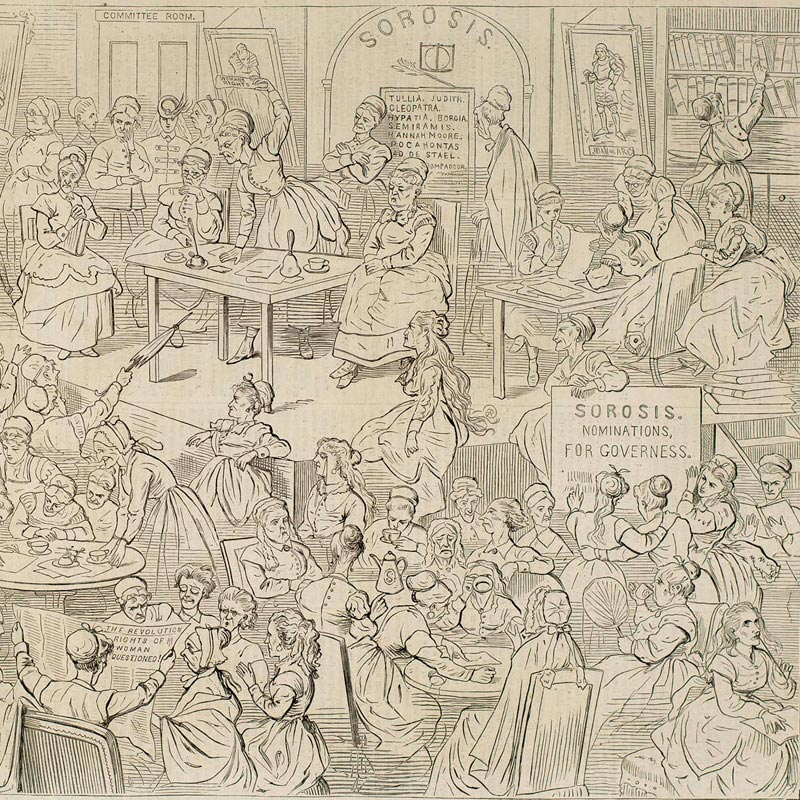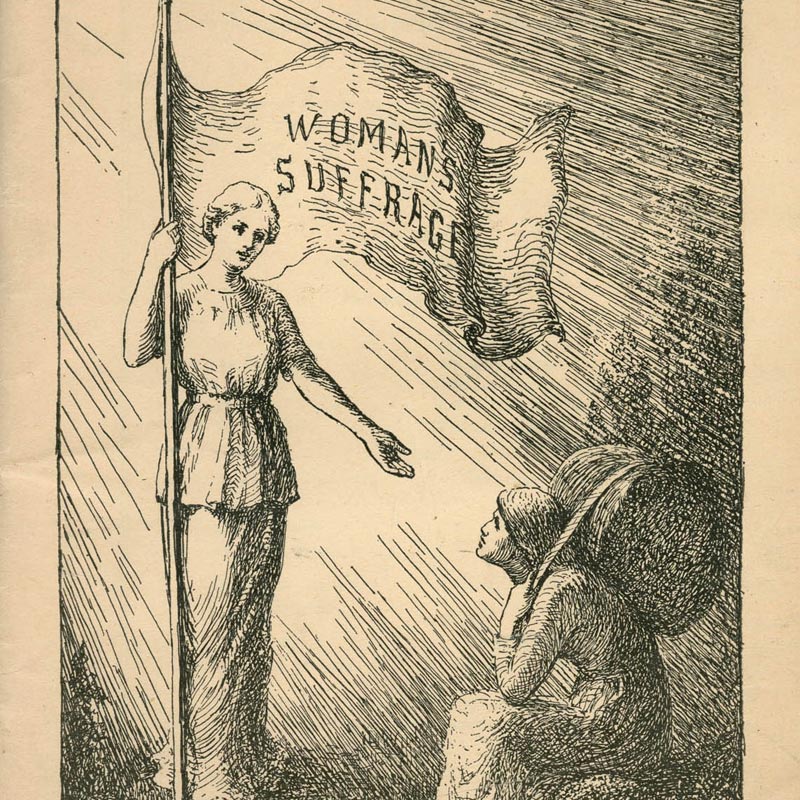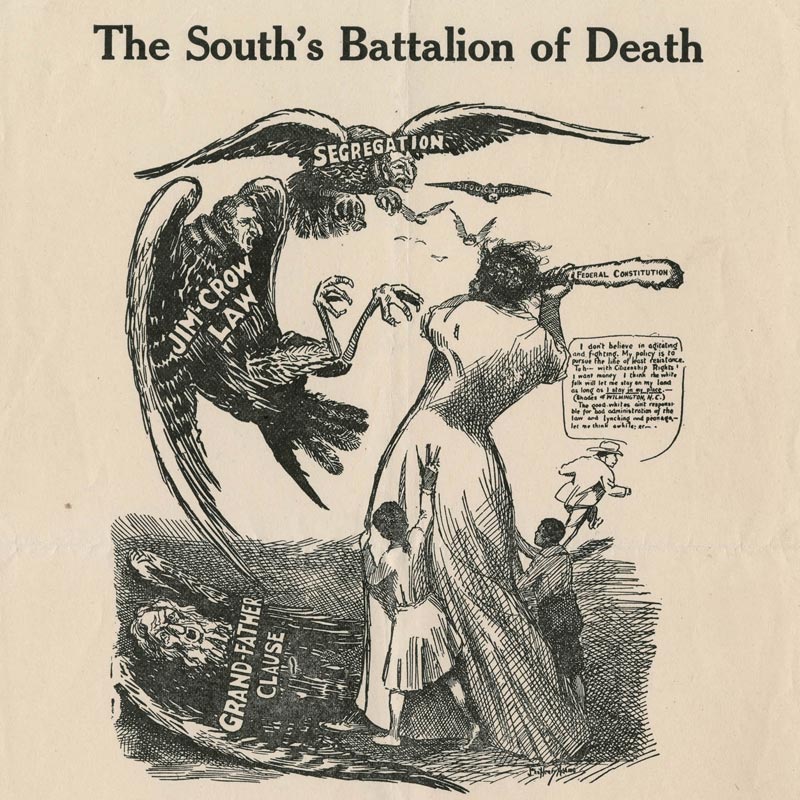






Political cartoons have long served to provoke public debate, illustrating opinions of the day for the masses. From early in the 19th century, arguments over voting rights—who votes and who counts the votes—have been depicted in cartoons, especially with the rise of illustrated newspapers and magazines with a national circulation before the Civil War.
The 19th-century ballot box was a hand-blown glass bowl contained in a frame to make voting “transparent.” It was an attempt to eliminate ballot box stuffing, but it became a ubiquitous symbol in political cartoons for voting rights or, as in this case, the abuse of voting rights.
Featuring examples of published cartoons from the MHS collections as well as other libraries and foundations, this exhibition illustrates how cartoonists helped to tell the story of voting rights in the United States. In addition to many drawings by Thomas Nast, the most influential American political cartoonist in the decades following the Civil War, this exhibition features modern reinterpretations of these topics by editorial cartoonists, including Herblock (Herbert Block), Tom Toles, Bill Mauldin, and the work of current Boston-area artists.
Expanding Voting Rights
Voting as a Civil Right
Thomas Nast, a young illustrator for Harper’s Weekly, gained an independent voice as a political cartoonist during the Civil War and Reconstruction and began to draw cartoons sympathetic to Black civil rights, including voting rights. The ratification of the 15th Amendment in 1870 did not end the struggle for voting rights. As Thomas Nast turned away from the long campaign he had waged with his pen, others, including Henry Jackson Lewis, a Black editorial cartoonist, carried the argument forward in the 1890s. Almost 100 years after Nast drew The Georgetown Election, a cartoon in support of Black voting rights, Herbert Block (“Herblock”) reiterated Nast’s argument in his cartoons from the 1950s and 1960s.
Click each image in the carousel for more information.
 "Pardon. Columbia—'Shall I Trust These Men, [Left page] Franchise. And Not This Man?'" [Right page]
"Pardon. Columbia—'Shall I Trust These Men, [Left page] Franchise. And Not This Man?'" [Right page]
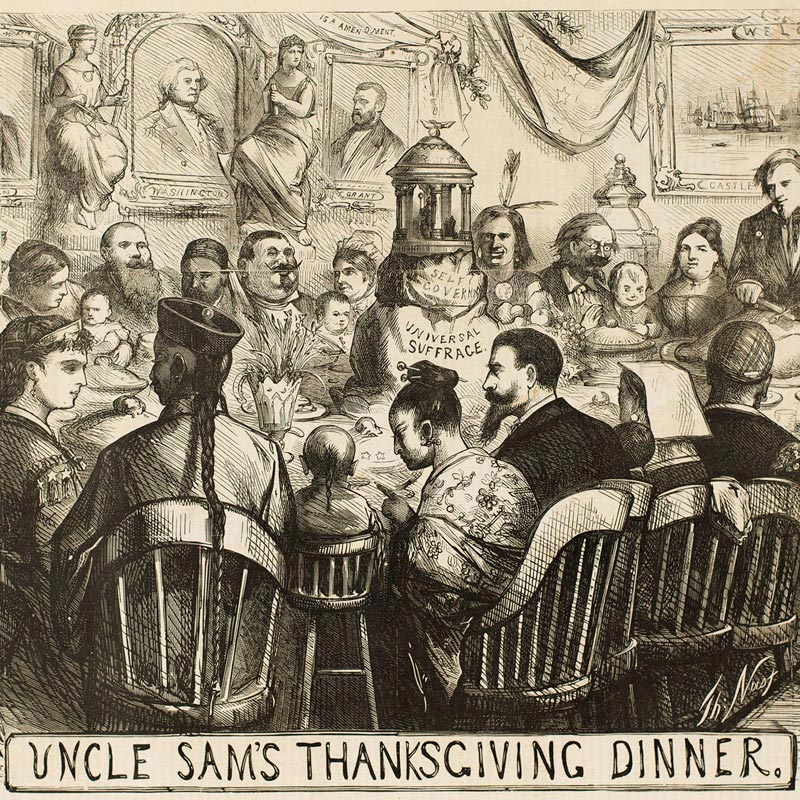 "Uncle Sam's Thanksgiving Dinner."
"Uncle Sam's Thanksgiving Dinner."
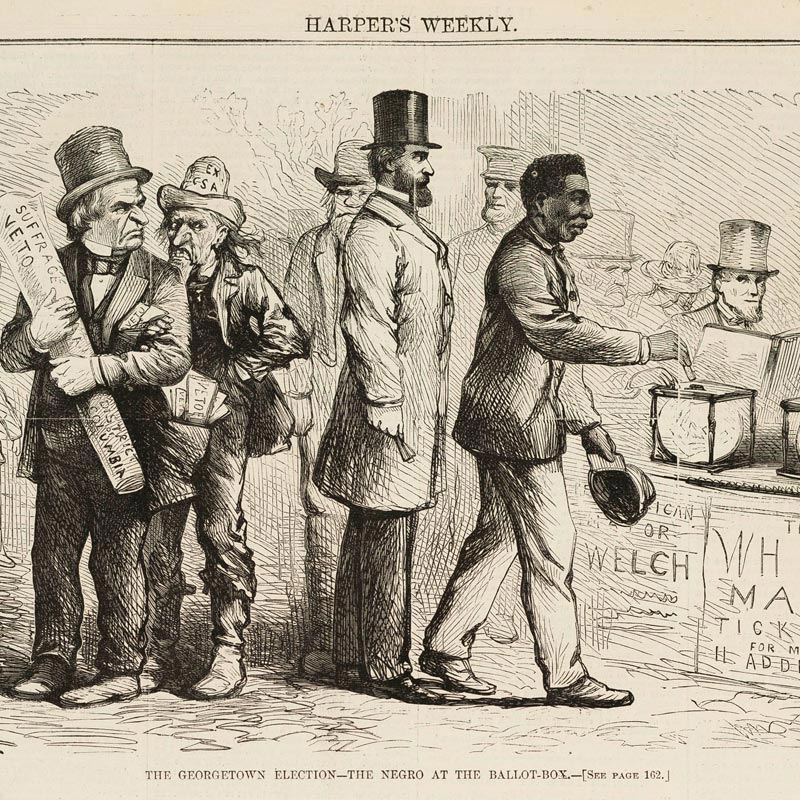 "The Georgetown Election--The Negro at the Ballot-Box."
"The Georgetown Election--The Negro at the Ballot-Box."
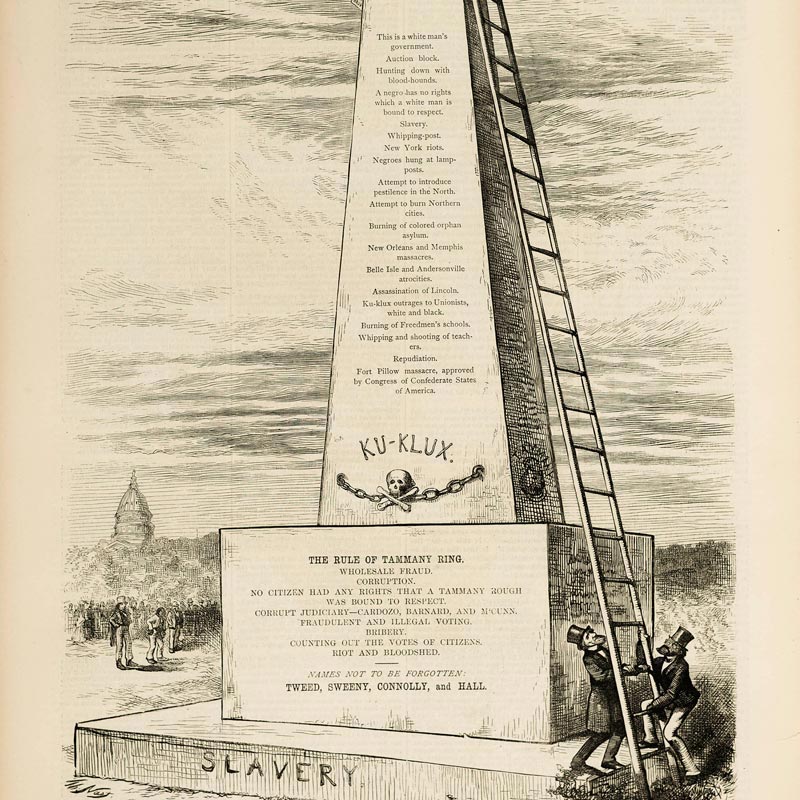 "The Whited Sepulchre. Covering the Monument of Infamy with his White Hat and Coat."
"The Whited Sepulchre. Covering the Monument of Infamy with his White Hat and Coat."
 "To Thine Own Self Be True."
"To Thine Own Self Be True."
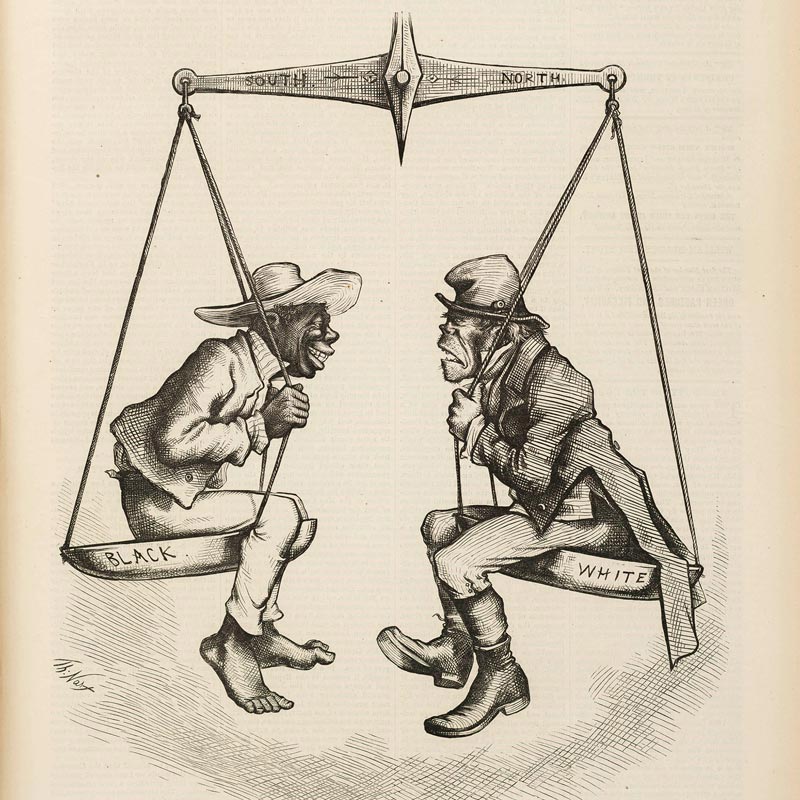 "The Ignorant Vote—Honors Are Easy."
"The Ignorant Vote—Honors Are Easy."
 "The Freeman’s Political Horoscope."
"The Freeman’s Political Horoscope."
 "Jericho, U. S. A."
"Jericho, U. S. A."
Political cartoon by Herb Block, published 21 March 1965. A 1965 Herblock Cartoon, © The Herb Block Foundation 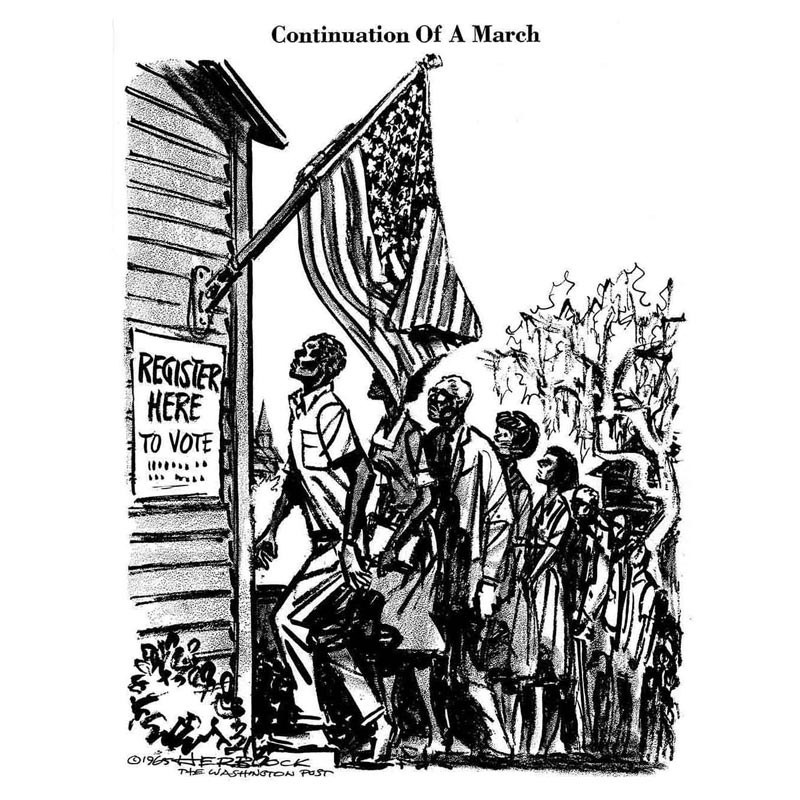 Continuation of a March.
Continuation of a March.
"The Freeman’s Political Horoscope."

Henry Jackson Lewis shows Black Americans struggling to surmount or break through a physical barrier to voting after the collapse of Reconstruction. African Americans are welcome into processions for all the major political parties except by Republicans, who by this time (1892) have become members of a "white man’s party."
"Jericho, U. S. A."

Political cartoons from the 1950s and 1960s drawn by "Herblock" (Herbert L. Block) for the Washington Post illustrate many of the same topics found in pro-civil rights cartoons by Thomas Nast and others from almost a century earlier. They tell the yet unfinished story of Black civil rights and voting rights—sometimes using remarkably similar imagery.
Continuation of a March.

Herblock celebrated the signing of the 1965 Voting Rights Act by President Lyndon Baines Johnson on 6 August 1965. Three years later, the assassination of Martin Luther King, Jr., unleashed social unrest that undercut the optimism found in Block’s earlier cartoons.
Women's Suffrage
Both pro– and anti–women’s suffrage organizations used images, including cartoons, to buttress their competing claims to represent the political views of women. Cartoonists—almost all men—lampooned women reformers and the organizations that they founded, even in publications sympathetic to women’s rights. Suffragists were depicted either as humorless “old maids” or as wild-eyed radicals. Meanwhile, a small cadre of politically active women cartoonists—and their male allies—drew in support of women’s suffrage.

Hugging a Delusion. Postcard by Laura E. Foster, 1915
Commissioned in 1915 by Life magazine and distributed by the New York State Association Opposed to Woman Suffrage, this cartoon depicts a woman cradling a ballot in her arms. Entitled "Hugging a Delusion," it suggests both that the ballot will not solve all of women’s problems and that voting would not be as satisfying to women as motherhood. In the 1910s, artist Laura Foster designed illustrations both for and against women’s suffrage. As a professional artist, she produced work to support herself regardless of her own viewpoint

"Make Way!" Cartoon by [Laura E. Foster]
Women cartoonists drew in support of and in opposition to the women’s suffrage campaign—and sometimes for both pro– and anti–women’s suffrage publications. Laura Foster, a transplanted Californian, came to New York and drew covers for Life that satirized the militant enthusiasm of the suffragists and questioned the illusory nature of their victories.
Learn more about the Suffrage movement in Massachusetts through our online web presentation, Massachusetts Debates a Woman's Right to Vote.
Voting by Mail
Civil War cartoonists and battlefield artists/reporters illustrated the large and enthusiastic “soldier vote” during the 1864 presidential election. Some northern states allowed votes to be cast by mail or by proxy in 1862 and then in much larger numbers in 1864. By the time of World War I, most states had adopted civilian absentee voting as a progressive reform. However, few soldiers overseas were able to vote in 1918, and voting by mail was not an option for civilians during the influenza epidemic that year. Segregationists in Congress staunchly opposed efforts to enfranchise Black soldiers serving overseas in World War II, viewing it as a “state’s rights” issue and undermining a second great “soldier vote” in 1944.

"Soldiers Mailing Their Votes." [Detail from "Election-Day. 8th November.'] Political cartoon, engraving by Thomas Nast
Thomas Nast’s celebration of the Republican Party’s election victory in 1864 (the “Union” ticket) shows, in a vignette within the engraving, soldiers casting their ballots by openly dropping them into “U.S.M[ail]” letter boxes.
(Sergeant) Bill Mauldin won his first Pulitzer Prize for editorial cartooning in 1945 for his World War II cartoons. In his memoir, Up Front, Mauldin observed that his cartoon about the "Soldier Vote" was the only drawing he had made during the war that he thought was a true editorial cartoon. While millions of soldiers voted by mail in 1944, southern legislators prevented Black soldiers from participating in the election.
More than six months ahead of the 2020 election, Tom Toles prophetically included a sign that read, "Notice: Post Office Out of Business," in a cartoon predicting potential problems with absentee voting.

"That’s Okay Joe…" Political cartoon by Bill Mauldin, 1944. Reproduced in Up Front in 1945. Courtesy, Bill Mauldin Estate, LLC.

TOLES © 2020 The Washington Post. Reprinted with permission of ANDREWS MCMEEL SYNDICATION. All rights reserved.
Attacking Limitations on Voting Rights
The Gerrymander
The Gerrymander by Elkanah Tisdale first appeared as a political cartoon in a Boston newspaper on March 26, 1812, and was quickly reprinted as a broadside with accompanying satirical verses. The Massachusetts legislature, controlled by Jeffersonian Republicans, had reapportioned state voting districts to favor their candidates. Their Federalist opponents struck back by adding wings to a map of a grotesquely shaped Essex County senatorial district, turning an effective political ploy into something truly monstrous—a salamander-like creature named for the Republican governor, Elbridge Gerry. Although the practice long preceded the term for it, “gerrymandering” is the gift of Massachusetts to the national—even international—political lexicon. Governor Gerry’s name, pronounced with a hard G, has been transformed into a soft G—“jerrymander.”
The legend of the gerrymander came into being in 1812 at a meeting of Federalist political leaders and newspapermen in Boston. Complaints about the efforts of their Jeffersonian Republican opponents to rig state elections by altering voting districts led artist Elkanah Tisdale to add a head and wings to an outlined map of a new senatorial district in Essex County and name it the “gerrymander” after the leader of the Jeffersonians, Gov. Elbridge Gerry. While a different map of Massachusetts that outlines the district in the context of Essex County shows that the district was not grotesquely misshapen by the standards of modern gerrymandering, the cartoon shocked the public and proved very effective.

His Excellency Elbridge Gerry LL.D. governor of Massachusetts. Mezzotint by John Rubens Smith, based on a painting by John Vanderlyn.
Is this the face that launched the manipulation of countless voting districts to gain political advantage? Some viewers see Elbridge Gerry’s craggy profile, in reverse of this image, under the wing of the monster in the Gerrymander cartoon.
Gov. Gerry, a signer of the Declaration of Independence who had refused to sign the Constitution because it lacked protections of personal liberty, became a fiercely partisan Jeffersonian Republican. Whether he was the instigator of the plan to protect his party’s advantage or only the signer of the bill named for him, it offered him no statewide advantage, as he was defeated for reelection in 1812.
Explore Contemporary Connection

Battle of the Gerrymanders, by E. J. Barnes, 2020
Political Corruption: “In Counting There Is Strength.”
Many 19th-century cartoons focus on political corruption—ballot box stuffing and vote buying—as a bar to voting rights. Thomas Nast drew his most famous cartoons in the course of his sustained attack on the Tweed Ring, named for William Marcy Tweed, who ruled New York City from Tammany Hall. As caricatured by Nast, the Tweed Ring became the embodiment of political venality. He pictured “Boss” Tweed boldly leaning on a ballot box, which bears the inscription: “In counting there is strength.”
While Nast was based in New York, he drew for a national audience. There were Massachusetts political figures tarnished by corruption—Benjamin F. Butler in particular—who were too (un)appealing not to caricaturize. In his cartoons, Nast also called out the hypocrisy of liberal reformers including Charles Francis Adams, who was depicted as the iceberg upon which Massachusetts Democrats wrecked in 1876.
Explore Contemporary Connection

Tide of Opinion, by David Friedman, 2020
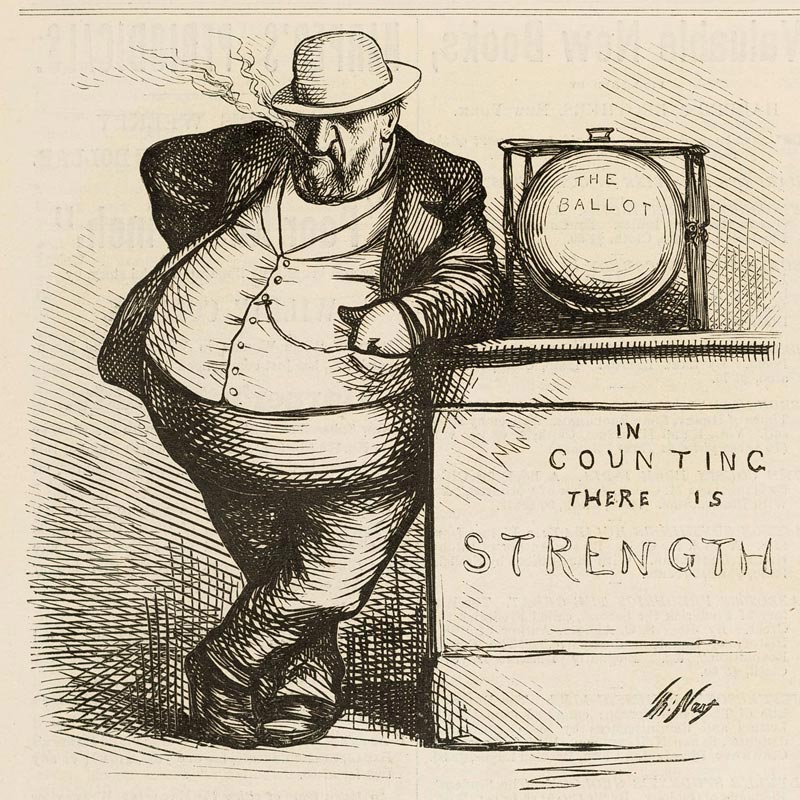 "'That's What's the Matter.' Boss Tweed. 'As long as I count the Votes, what are you going to do about it? say?'"
"'That's What's the Matter.' Boss Tweed. 'As long as I count the Votes, what are you going to do about it? say?'"
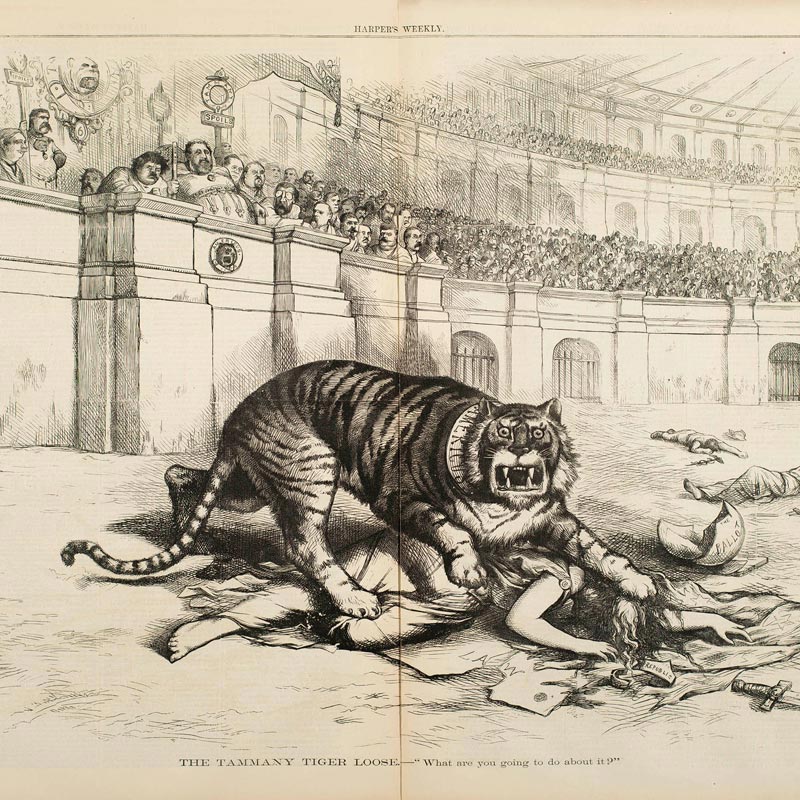 "The Tammany Tiger Loose--'What are you going to do about it?'"
"The Tammany Tiger Loose--'What are you going to do about it?'"
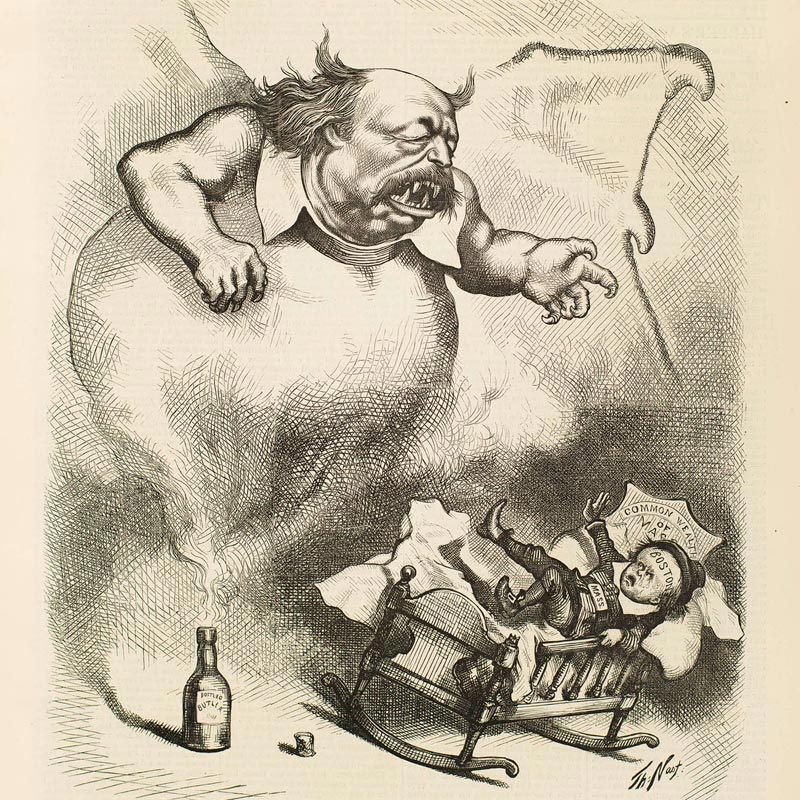 "The Cradle of Liberty in Danger."
"The Cradle of Liberty in Danger."
 Two Old-Time Standard-Bearers of Public Morality.
Two Old-Time Standard-Bearers of Public Morality.
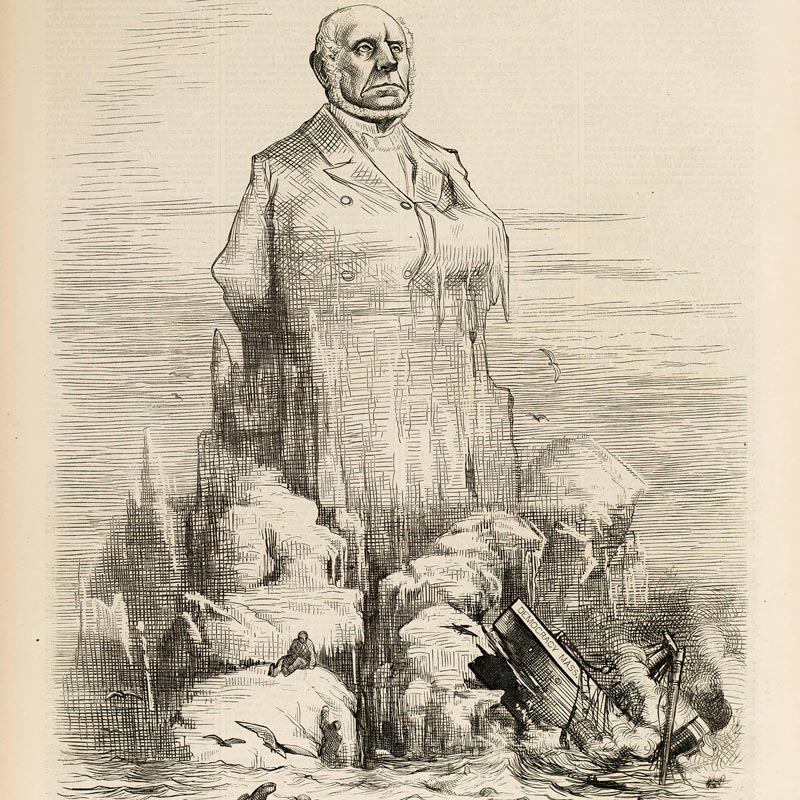 "Struck--At Sea. If it had not been for that haze (Hayes), they could have steered clear of the iceberg."
"Struck--At Sea. If it had not been for that haze (Hayes), they could have steered clear of the iceberg."
The Electoral College
Until the contested results of the Hayes-Tilden presidential election in 1876, there were few early “Electoral College” cartoons. These cartoons, for the most part, do not address the role of the Electoral College in constraining voting rights. Cartoonists protested political chicanery but not the underlying system that put presidential elections in the hands of a “college” of electors rather than the popular vote of the people.
In more recent times, editorial cartoonist Herblock returned to the topic of the Electoral College during presidential campaigns. His cartoons warn of the danger that the Electoral College would produce an election result at odds with the popular vote. Although there were some close calls, his prophetic warning came true in 2000 at the end of his long career, when George W. Bush, the winner of the electoral vote, defeated Albert Gore, who captured the popular vote.
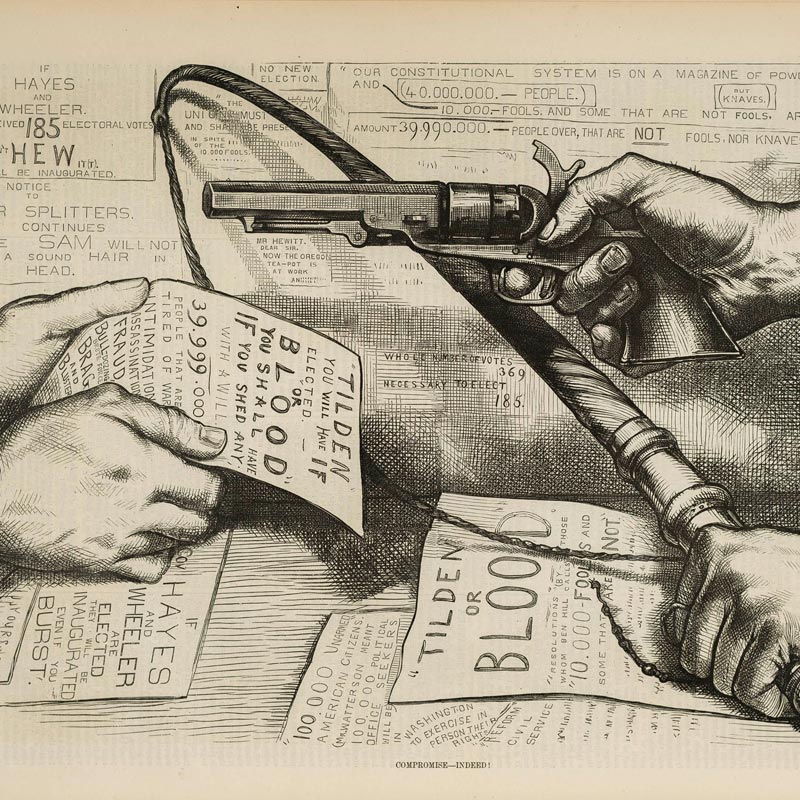 "Compromise—Indeed!"
"Compromise—Indeed!"
 "A National Game That is Played Out."
"A National Game That is Played Out."
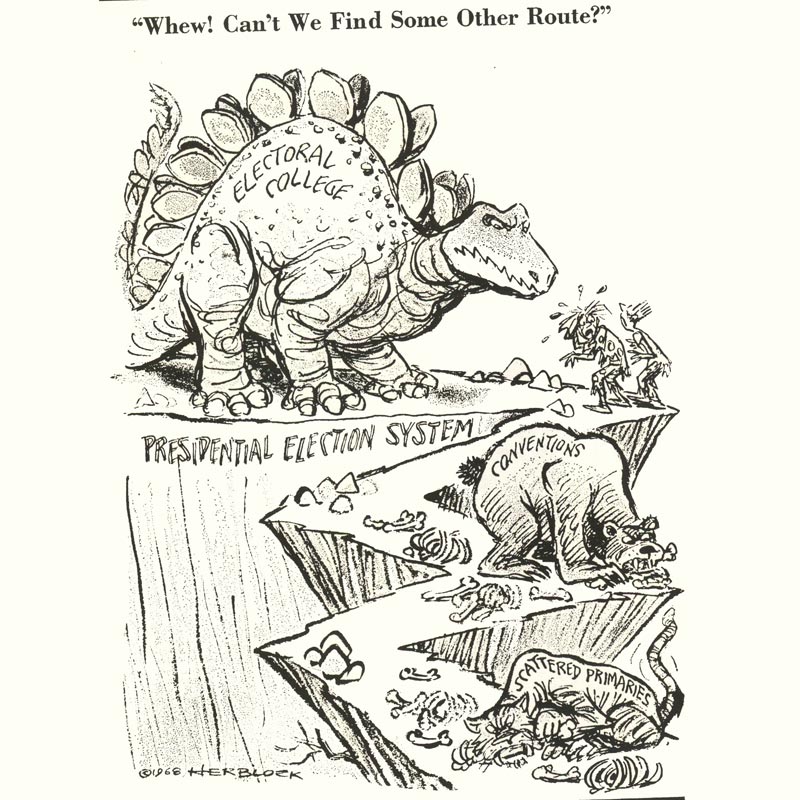 “Whew! Can’t We Find Some Other Route?”
“Whew! Can’t We Find Some Other Route?”
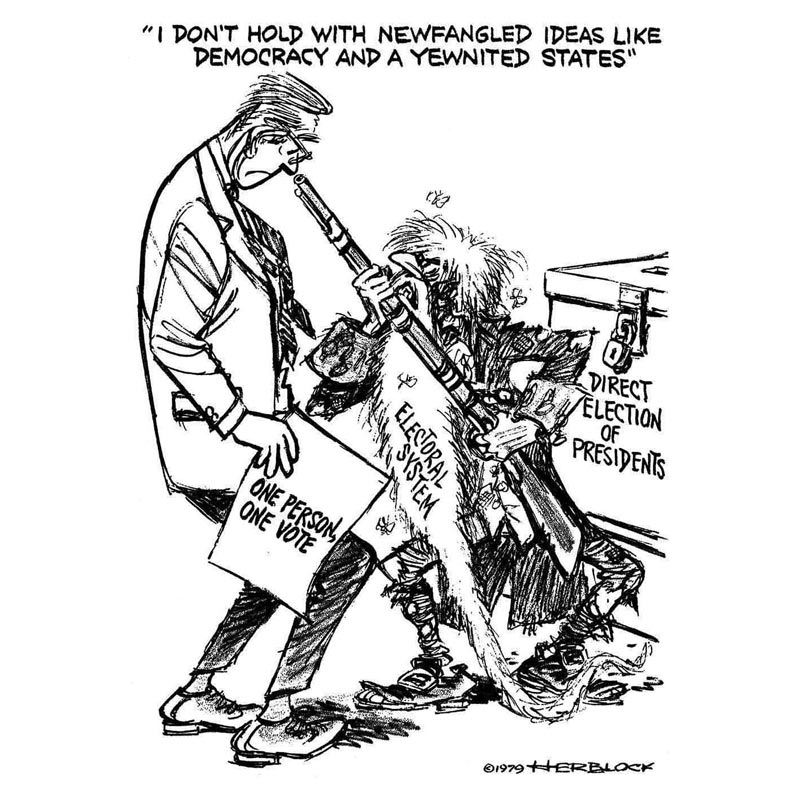 I Don't Hold With Newfangled Ideas Like Democracy and a Yewnited States.
I Don't Hold With Newfangled Ideas Like Democracy and a Yewnited States.
Political cartoon by Herb Block, published 10 July 1979. A 1979 Herblock Cartoon, © The Herb Block Foundation  "Apparently there is a ‘side door’ of college admissions that some people use to get into places they didn’t earn."
"Apparently there is a ‘side door’ of college admissions that some people use to get into places they didn’t earn."
Political cartoon by Tom Toles, March 2019. TOLES © 2019 The Washington Post. Reprinted with permission of ANDREWS MCMEEL SYNDICATION. All rights reserved.
“Whew! Can’t We Find Some Other Route?”

In editorial cartoons dating back to the extremely close 1960 presidential election, Herblock prophesied political disaster if the electoral vote was at odds with the popular vote. Every four years he would warn against burdens and obstructions that could prevent a fair presidential election, but always returned to the antiquated Electoral College system, portrayed here as a dinosaur blocking the tortuous path to the 1968 election.
I Don't Hold With Newfangled Ideas Like Democracy and a Yewnited States.

Herblock continued his crusade against the Electoral College throughout his long editorial career. In 1979,during a presidential campaign that ended in a landslide popular vote and Electoral College victory for Ronald Reagan, Block satirized voters who did not “Hold With Newfangled Ideas Like Democracy.”
"Apparently there is a ‘side door’ of college admissions that some people use to get into places they didn’t earn."

In March 2019, at the beginning of the present presidential campaign season, Tom Toles compared the Electoral College to revelations of cheating and bribery in college admissions. Presidential candidates were able to enter the White House, a place "they didn’t earn" by popular vote, through the side door of the Electoral College.


